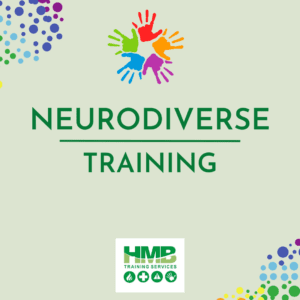Welcome to our blog dedicated to promoting neurodiversity in the workplace! Here we explain the top 5 tips how to help neurodiversity in the workplace. In today’s fast-paced and dynamic world, diversity is not just a buzzword—it’s a necessity. Embracing neurodiversity, which encompasses a wide range of neurological differences such as autism, ADHD, dyslexia, and more, is crucial for fostering innovation, creativity, and inclusivity in the workplace.
In this blog, we’ll be exploring the top five tips on how to support neurodiversity in the workplace. From creating inclusive environments to providing tailored accommodations, we’ll dive into practical strategies for empowering neurodiversity individuals to thrive in their professional lives.
Whether you’re an employer looking to create a more inclusive workplace culture or an individual interested in learning more about neurodiversity, this blog is for you. So, let’s embark on this journey together and discover how we can all play a role in championing neurodiversity in the workplace.
Understanding Neurodiversity: Embracing the Spectrum
In today’s society, diversity is celebrated in all its forms—gender, race, ethnicity, and more. However, there’s one aspect of diversity that often goes unnoticed or misunderstood: neurodiversity. Neurodiversity refers to the natural variation in the human brain, encompassing a wide range of neurological differences such as autism, ADHD, dyslexia, and Tourette syndrome.
Embracing neurodiversity means recognising and appreciating the unique perspectives, strengths, and challenges that neurodiversity individuals bring to our communities and workplaces. It’s about understanding that there’s no one “normal” way for the brain to function and that diversity of thought is essential for innovation and progress.
At its core, neurodiversity challenges us to move beyond stereotypes and preconceived notions, and instead, to embrace the rich tapestry of human cognition. It calls for environments that are inclusive, accommodating, and supportive of individuals with diverse neurological profiles.
To truly embrace the spectrum of neurodiversity, we must commit to fostering understanding, empathy, and acceptance. It requires us to challenge stigma and discrimination, and to create spaces where everyone feels valued and respected for who they are.
Breaking Down the Myths: Debunking Common Misconceptions
In our society, misconceptions and stereotypes often surround topics that are not well understood. When it comes to neurodiversity, these misconceptions can lead to stigma, discrimination, and barriers to inclusion. We’ll explore some of the most common myths about neurodiversity and debunk them with facts and evidence.
Myth: Neurodiversity individuals are less intelligent. Fact: Intelligence is not determined by neurodiversity. Many neurodiversity individuals excel in areas such as creativity, problem-solving, and innovation. Neurodiversity is simply a variation in the way the brain functions, and it does not diminish a person’s intelligence or worth.
Myth: Neurodiversity individuals are unable to succeed in the workplace. Fact: Neurodiversity individuals have unique strengths and talents that can be valuable in the workplace. With the right support and accommodations, they can thrive in various roles and contribute to the success of their teams and organisations.
Myth: Neurodiversity is a rare condition. Fact: Neurodiversity is more common than many people realise. It encompasses a wide range of conditions, including autism, ADHD, dyslexia, and more. In fact, it’s estimated that neurodiversity traits are present in a significant portion of the population.
Myth: Neurodiversity individuals are all the same. Fact: Neurodiversity is a spectrum, meaning that there is a wide variation in the way neurodiversity traits manifest in different individuals. Each person is unique, with their own strengths, challenges, and preferences.
Myth: Neurodiversity is a problem that needs to be fixed. Fact: Neurodiversity is not a problem to be solved, but rather a natural variation in human cognition. It is a valuable part of our society and contributes to the diversity of thought and experience that drives progress and innovation.
By debunking these myths and promoting a better understanding of neurodiversity, we can create more inclusive and supportive environments for neurodiversity individuals. Let’s challenge stereotypes, embrace diversity, and celebrate the unique talents and perspectives that neurodiversity brings to our world.
Navigating Challenges: Supporting Neurodiversity Individuals
In today’s diverse workplaces, it’s crucial to recognise and support the unique needs of all employees, including those who are neurodiversity. Neurodiversity encompasses a broad spectrum of neurological differences, such as autism, ADHD, dyslexia, and more. While neurodiverse individuals bring valuable perspectives and talents to the table, they may also face specific challenges in navigating the demands of the workplace. We’ll explore strategies for effectively supporting neurodiversity individuals and fostering an inclusive and supportive work environment.
Understanding Neurodiversity:
-
- Define neurodiversity and highlight the range of neurological differences it encompasses.
- Emphasise the importance of recognising neurodiversity as a natural variation in human cognition.
- Discuss common neurodiversity traits and challenges faced by individuals on the spectrum.
Creating Inclusive Work Environments:
-
- Promote awareness and education about neurodiversity among employees and managers.
- Foster a culture of acceptance, empathy, and respect for neurodiverse individuals.
- Provide training and resources for managers and colleagues on how to effectively support neurodiversity colleagues.
Accommodations and Support:
-
- Offer reasonable accommodations tailored to the specific needs of neurodiversity individuals.
- Provide access to assistive technologies, flexible work arrangements, and sensory-friendly workspaces.
- Establish clear communication channels for neurodiversity individuals to express their needs and concerns.
Building Neurodiversity Teams:
-
- Recognise and leverage the unique strengths and talents of neurodiversity individuals.
- Foster collaboration and teamwork by creating diverse teams that value different perspectives.
- Encourage open communication and mutual respect among team members.
Advocacy and Ally ship:
-
- Encourage neurodiversity individuals to advocate for themselves and their needs in the workplace.
- Promote allyship among colleagues and managers by actively supporting and advocating for neurodiversity initiatives.
- Advocate for organizational policies and practices that promote inclusivity and support neurodiversity individuals.
Sensory Difficulties Neurodiverse people have in the workplace
Sensory problems in the workplace can vary widely depending on an individual’s neurodiversity and sensory sensitivities. Some common sensory challenges that people may experience in the workplace include:
- Overstimulation: Loud noises, bright lights, strong smells, and crowded spaces can be overwhelming for individuals with sensory sensitivities, leading to difficulty concentrating and increased stress levels.
- Sensory Hypersensitivity: Some individuals may have heightened sensitivity to sensory stimuli, making them more susceptible to sensory overload. For example, fluorescent lighting or background noise may cause discomfort or even physical pain.
- Sensory Seeking Behaviour: On the other hand, some individuals may seek out sensory
 stimulation to regulate their sensory experiences. This could manifest as fidgeting, tapping, or rocking back and forth in their chair.
stimulation to regulate their sensory experiences. This could manifest as fidgeting, tapping, or rocking back and forth in their chair.- Sensory Integration Difficulties: Difficulty processing and integrating sensory information from the environment can affect an individual’s ability to focus, communicate, and interact with others effectively.
- Sensory-Friendly Workspaces: Creating a sensory-friendly workspace with adjustable lighting, noise-cancelling headphones, and designated quiet areas can help mitigate sensory challenges and support neurodiverse employees.
- Communication Challenges: Sensory issues can also impact communication, making it difficult for individuals to express their needs or understand verbal and nonverbal cues from others.
- Sensory Overload Triggers: Identifying and minimising sensory overload triggers in the workplace, such as excessive background noise or strong smells, can help create a more comfortable and productive environment for everyone.
- Flexible Accommodations: Offering flexible accommodations, such as remote work options or flexible scheduling, can allow individuals to better manage their sensory sensitivities and optimize their productivity.
Overall, understanding and accommodating sensory challenges in the workplace is essential for creating an inclusive environment where all employees can thrive. By implementing strategies to address sensory issues, organizations can support the diverse needs of their employees and foster a more inclusive and supportive workplace culture.
Top 5 Tips How to Help Neurodiversity in the Workplace
- Promote Awareness and Education:
- Provide training sessions or workshops to raise awareness about neurodiversity among employees and managers.
- Offer educational resources and materials to help colleagues understand different neurodiverse conditions and how they may impact individuals in the workplace.
- Encourage open dialogue and discussions about neurodiversity to foster a culture of understanding and acceptance.
- Create an Inclusive Environment:
- Foster a culture of inclusivity where all employees feel valued, respected, and supported, regardless of their neurodiversity.
- Implement policies and practices that promote diversity and inclusion, such as flexible work arrangements, accessible facilities, and zero-tolerance for discrimination.
- Provide resources and support networks for neurodiverse employees, such as employee resource groups or mentorship programs.
- Offer Reasonable Accommodations:
- Provide reasonable accommodations tailored to the specific needs of neurodiverse individuals, such as flexible scheduling, noise-cancelling headphones, or designated quiet areas.
- Work with neurodiverse employees to identify their individual needs and preferences, and collaborate to find solutions that support their success in the workplace.
- Ensure that accommodations are implemented consistently and effectively, and regularly check in with employees to assess their ongoing needs.
- Foster Communication and Understanding:
- Encourage open communication between managers, colleagues, and neurodiverse employees to facilitate understanding and collaboration.
- Provide training on effective communication strategies, such as clear and concise instructions, active listening, and nonverbal communication cues.
- Foster a supportive and inclusive team environment where employees feel comfortable discussing their challenges and seeking help when needed.
- Lead by Example:
- Lead by example by demonstrating inclusive behaviour and attitudes towards neurodiversity in the workplace.
- Advocate for neurodiversity initiatives and policies within your organisation, and actively support efforts to create a more inclusive and supportive work environment.
- Encourage and empower neurodiverse employees to share their perspectives and contribute their unique talents to the team.
By following these top 5 tips How to Help Neurodiversity in the Workplace, organisations can create a more inclusive and supportive workplace culture where neurodiverse employees can thrive and contribute their full potential.
Introducing neurodiversity training for the workplace
Did you know that just 21.7% of autistic adults in the UK are in any form of paid employment.
This is amongst the lowest rates of employment for people with additional needs or disabilities. With the help of HMB Training Services spreading awareness of neurodiversity can help employ staff who have great skills for the job regardless of their neurodiversity.
Neurodiversity Training for the Workplace for managers, HR personnel and colleagues. The session aims to increase awareness of neurodiversity in the workplace and allow attendees the opportunity to discuss workplace specific circumstances, develop strategies to support a neurodiverse workforce and identify the next steps for their organisation.
About the Trainer
Heather Bird has vast experience and knowledge of children and adults with Autism and ADHD. Heather has over 13 years experience and understanding having worked in schools and can bring that experience to the classroom. Learners will go away with a much better understanding of the problems that neurodiverse individuals face and be equipped with tips and strategies to put into practice at your workplace.
How to Book Neurodiversity Training for the Workplace
To contact us or to view our open courses click here for more information here: https://www.hmbtrainingservices.co.uk/contact.
Our Neurodiversity Training for the Workplace course will be delivered at your workplace. Open courses will be made available in the near future.
Additionally, to discuss your requirements please call us on 01543 453338 or email us at info@hmbtrainingservices.co.uk




